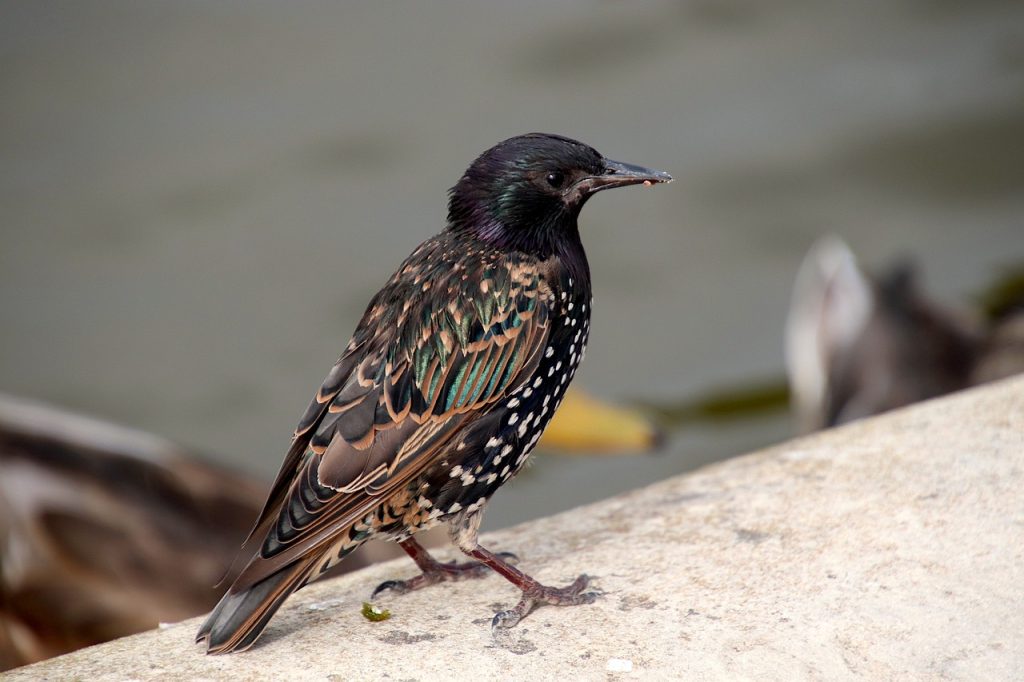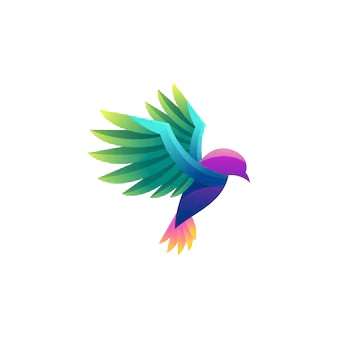
The UK might not be famed for its colorful birds, but it boasts an impressive variety of black and white birds. For bird enthusiasts who appreciate the elegance of monochrome feathers, the UK offers a plethora of species to observe. This article highlights 26 black and white birds you can spot across the UK, excluding rare visitors and birds with minimal black and white plumage.
Whether you’re exploring urban gardens, coastal cliffs, or dense woodlands, keep an eye out for these distinctive birds. Note that in some species, only the males exhibit black and white plumage, while females may be more muted in color.
1. House Martin (Delichon urbicum)
- Lifespan: 3-5 years
- Size: 13 cm (5 in)
- Weight: 15-20 g (0.5-0.7 oz)
- Wingspan: 26-29 cm (10-11.5 in)
- Population: 510,000 breeding pairs
- Habitat: Urban and suburban areas, often nesting on buildings
- Status: Red
House Martins are speedy insect hunters and frequent visitors in spring, summer, and autumn. However, their numbers are declining, putting them on the red list for UK birds.
2. Hooded Crow (Corvus cornix)
- Lifespan: 6-8 years
- Size: 48 cm (19 in)
- Weight: 400 g (14 oz)
- Wingspan: 85-100 cm (33-39 in)
- Population: 285,000 breeding territories
- Habitat: Open country, farmlands, and urban areas
- Status: Green
Recognized as a separate species since 2002, Hooded Crows are intelligent and territorial. They are distinguished by their significant white body parts and are usually seen in pairs rather than large flocks.
3. Rook (Corvus frugilegus)
- Lifespan: 10-15 years
- Size: 45 cm (18 in)
- Weight: 400 g (14 oz)
- Wingspan: 81-100 cm (32-39 in)
- Population: 1,100,000 breeding pairs
- Habitat: Farmlands, woodlands, and urban areas
- Status: Green
Rooks are notable for their sociable nature and distinctive white beaks. Though still numerous, their population has declined by about 20% from 1995 to 2020.
4. Magpie (Pica pica)
- Lifespan: 3-5 years (wild)
- Size: 44-46 cm (17-18 in)
- Weight: 150-250 g (5-9 oz)
- Wingspan: 52-60 cm (20-24 in)
- Population: 600,000 breeding territories
- Habitat: Woodlands, parks, and gardens
- Status: Green
Magpies, with their long tails and striking mix of black, white, and blue, are a common sight in the UK. Their distinctive appearance makes them easy to spot.
5. Long-tailed Tit (Aegithalos caudatus)
- Lifespan: 3 years
- Size: 14 cm (5.5 in)
- Weight: 5-8 g (0.18-0.28 oz)
- Wingspan: 22-24 cm (8.7-9.4 in)
- Population: 340,000 breeding territories
- Habitat: Woodlands, hedgerows, and gardens
- Status: Green
The Long-tailed Tit is a tiny, active bird with a distinctive long tail and bouncy flight. Their loud calls often give away their presence before they are seen.
6. Coal Tit (Periparus ater)
- Lifespan: 3 years
- Size: 11.5 cm (4.5 in)
- Weight: 9 g (0.32 oz)
- Wingspan: 18-20 cm (7-7.9 in)
- Population: 670,000-680,000 breeding territories
- Habitat: Woodlands, especially coniferous forests, and gardens
- Status: Green
Coal Tits are tiny, energetic birds often found in coniferous areas. They are constantly on the move, searching for insects and seeds.
7. Great Spotted Woodpecker (Dendrocopos major)
- Lifespan: 5-6 years
- Size: 23 cm (9 in)
- Weight: 70-90 g (2.5-3.2 oz)
- Wingspan: 34-39 cm (13-15 in)
- Population: 140,000 breeding pairs
- Habitat: Woodlands and gardens
- Status: Green
Great Spotted Woodpeckers are known for their drumming on trees. Males have a red spot on the back of their heads, and both sexes have red under-tail plumage.
8. Lesser Spotted Woodpecker (Dryobates minor)
- Lifespan: 2-3 years
- Size: 15 cm (6 in)
- Weight: 20-30 g (0.7-1.1 oz)
- Wingspan: 25-30 cm (10-12 in)
- Population: 800-1,000 breeding pairs
- Habitat: Woodlands and parks
- Status: Red
The Lesser Spotted Woodpecker is much smaller and harder to spot than its larger relative. Its population has significantly declined, and the reasons remain unclear.
9. Gannet (Morus bassanus)
- Lifespan: 20-30 years
- Size: 90-110 cm (35-43 in)
- Weight: 2.2-3.6 kg (4.9-7.9 lbs)
- Wingspan: 165-180 cm (65-71 in)
- Population: 220,000-295,000 nest sites
- Habitat: Coastal cliffs and open seas
- Status: Amber
Gannets are large, striking seabirds. They breed in large, noisy colonies on protected coastal cliffs.
10. Black-legged Kittiwake (Rissa tridactyla)
- Lifespan: 15-25 years
- Size: 37-41 cm (15-16 in)
- Weight: 305-525 g (11-18.5 oz)
- Wingspan: 91-96 cm (36-38 in)
- Population: 380,000 pairs
- Habitat: Coastal cliffs and islands
- Status: Red
These gull-like birds have black legs and spend the winter at sea. Unlike other gulls, Kittiwakes prefer to stay away from humans.
11. Oystercatcher (Haematopus ostralegus)
- Lifespan: 15-30 years
- Size: 40-45 cm (16-18 in)
- Weight: 350-550 g (12.3-19.4 oz)
- Wingspan: 83-90 cm (33-35 in)
- Population: 96,000 breeding pairs
- Habitat: Coastal areas, estuaries, and shorelines
- Status: Amber
Oystercatchers are easily recognized by their bright orange legs, beak, and eyes. Their numbers increase in winter due to an influx of birds from Norway.
12. Puffin (Fratercula arctica)
- Lifespan: 20 years
- Size: 28-34 cm (11-13 in)
- Weight: 300-500 g (10.6-17.6 oz)
- Wingspan: 47-63 cm (18.5-25 in)
- Population: 580,000 breeding pairs
- Habitat: Coastal cliffs and islands
- Status: Red
Puffins, known for their colorful beaks and clownish appearance, are declining in number. Conservation efforts are ongoing to protect these beloved birds.
13. Barnacle Goose (Branta leucopsis)
- Lifespan: 10-20 years
- Size: 55-70 cm (22-28 in)
- Weight: 1.2-2.3 kg (2.6-5.1 lbs)
- Wingspan: 130-145 cm (51-57 in)
- Population: 1,550 breeding pairs
- Habitat: Coastal areas, tundra, and wetlands
- Status: Amber
Originally winter visitors, some Barnacle Geese now reside in the UK year-round. Their fascinating migratory patterns are well-studied.
14. Coot (Fulica atra)
- Lifespan: 5-7 years
- Size: 36-38 cm (14-15 in)
- Weight: 600-1,000 g (1.3-2.2 lbs)
- Wingspan: 75-85 cm (30-33 in)
- Population: 26,000 breeding pairs
- Habitat: Freshwater lakes, ponds, and marshes
- Status: Green
Coots are common pond and lake birds, often seen diving for food. Their white faces and beaks make them easy to identify.
15. Common Gull (Larus canus)
- Lifespan: 15 years
- Size: 40-46 cm (16-18 in)
- Weight: 300-500 g (10.6-17.6 oz)
- Wingspan: 110-125 cm (43-49 in)
- Population: 50,000-70,000 breeding pairs
- Habitat: Coastal and inland waters
- Status: Green
The Common Gull, also known as the Mew Gull in North America, is less aggressive than other gulls and has a more delicate appearance.
16. Little Gull (Hydrocoloeus minutus)
- Lifespan: 10-15 years
- Size: 24-28 cm (9.5-11 in)
- Weight: 90-135 g (3.2-4.8 oz)
- Wingspan: 61-78 cm (24-31 in)
- Population: Rare breeding in the UK
- Habitat: Coastal waters and inland lakes
- Status: Green
The smallest of the gulls, Little Gulls are rare breeders in the UK but are often seen during migration periods.
17. Black Guillemot (Cepphus grylle)
- Lifespan: 10-20 years
- Size: 32-38 cm (13-15 in)
- Weight: 300-460 g (10.6-16.2 oz)
- Wingspan: 49-58 cm (19-23 in)
- Population: 19,000 pairs
- Habitat: Coastal cliffs and rocky shores
- Status: Green
Black Guillemots are unique for their striking black and white plumage and bright red legs and feet. They are more commonly found in northern Scotland.
18. Razorbill (Alca torda)
- Lifespan: 20 years
- Size: 37-39 cm (14.5-15.5 in)
- Weight: 550-730 g (19-25 oz)
- Wingspan: 63-68 cm (25-27 in)
- Population: 170,000 pairs
- Habitat: Coastal cliffs and open seas
- Status: Amber
Razorbills are seabirds with a sharp bill and a distinctive black and white coloration. They often nest on narrow ledges of cliffs.
19. Pied Flycatcher (Ficedula hypoleuca)
- Lifespan: 3-5 years
- Size: 12-13.5 cm (4.7-5.3 in)
- Weight: 12-15 g (0.42-0.53 oz)
- Wingspan: 22-24 cm (8.7-9.4 in)
- Population: 44,000 breeding pairs
- Habitat: Deciduous woodlands
- Status: Amber
Pied Flycatchers are summer visitors to the UK, where they breed in natural cavities and nest boxes.
20. Avocet (Recurvirostra avosetta)
- Lifespan: 15-20 years
- Size: 42-45 cm (16.5-18 in)
- Weight: 260-290 g (9.2-10.2 oz)
- Wingspan: 77-80 cm (30-31.5 in)
- Population: 1,500 breeding pairs
- Habitat: Coastal lagoons and estuaries
- Status: Amber
Avocets are elegant wading birds with long, upturned bills. They are a success story for UK conservation efforts, having been re-established in several areas.
21. Great Black-backed Gull (Larus marinus)
- Lifespan: 20-30 years
- Size: 64-79 cm (25-31 in)
- Weight: 1.5-2 kg (3.3-4.4 lbs)
- Wingspan: 150-170 cm (59-67 in)
- Population: 16,000 breeding pairs
- Habitat: Coastal areas
- Status: Green
The Great Black-backed Gull is the largest gull in the world, known for its imposing size and aggressive nature.
22. Lapwing (Vanellus vanellus)
- Lifespan: 5-10 years
- Size: 28-31 cm (11-12 in)
- Weight: 128-330 g (4.5-11.6 oz)
- Wingspan: 67-72 cm (26-28 in)
- Population: 140,000 breeding pairs
- Habitat: Farmlands and wetlands
- Status: Red
Lapwings are easily recognized by their striking black and white plumage and distinctive crests. Their populations have been declining, making them a conservation priority.
23. Black Tern (Chlidonias niger)
- Lifespan: 10-15 years
- Size: 24-28 cm (9.5-11 in)
- Weight: 60-75 g (2.1-2.6 oz)
- Wingspan: 57-65 cm (22-25.6 in)
- Population: Rare breeder
- Habitat: Freshwater marshes and coastal areas
- Status: Amber
Black Terns are migratory birds that breed in Europe and spend the winter in Africa. They are rare visitors to the UK.
24. Ring Ouzel (Turdus torquatus)
- Lifespan: 3-4 years
- Size: 24-27 cm (9.4-10.6 in)
- Weight: 90-135 g (3.2-4.8 oz)
- Wingspan: 38-42 cm (15-16.5 in)
- Population: 5,000-7,500 pairs
- Habitat: Upland moors and rocky areas
- Status: Red
Ring Ouzels are thrush-like birds with a distinctive white ring around their necks. They are often found in mountainous areas.
25. Common Eider (Somateria mollissima)
- Lifespan: 20-30 years
- Size: 50-71 cm (20-28 in)
- Weight: 1.6-2.8 kg (3.5-6.2 lbs)
- Wingspan: 80-110 cm (31-43 in)
- Population: 33,500 breeding pairs
- Habitat: Coastal waters and islands
- Status: Amber
Eiders are large sea ducks known for their down, which is harvested for its insulating properties. They are a common sight in coastal areas during the breeding season.
26. Great Northern Diver (Gavia immer)
- Lifespan: 20-25 years
- Size: 61-102 cm (24-40 in)
- Weight: 3.6-6.4 kg (7.9-14.1 lbs)
- Wingspan: 127-152 cm (50-60 in)
- Population: Winter visitor
- Habitat: Coastal waters
- Status: Green
The Great Northern Diver, also known as the Common Loon, is a winter visitor to the UK. They are known for their haunting calls and distinctive breeding plumage.
Conclusion
The UK is home to a fascinating array of black and white birds. From the familiar Magpie to the striking Puffin, these species showcase the diversity and beauty of the UK’s avian life. Observing these birds can provide insight into their behaviors, habitats, and the conservation efforts needed to protect them. Whether you’re a seasoned birder or a curious beginner, keep an eye out for these elegant birds on your next outdoor adventure.
